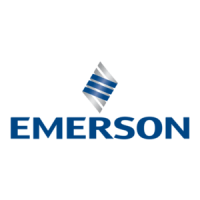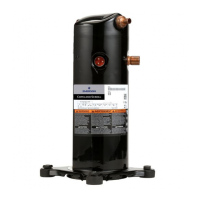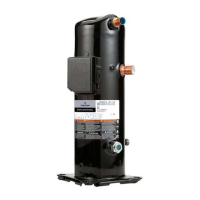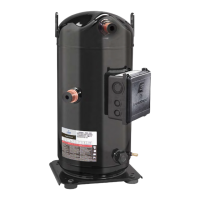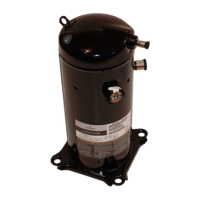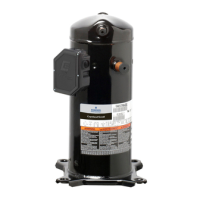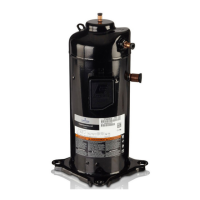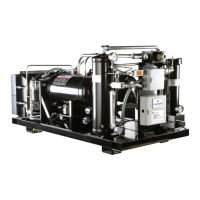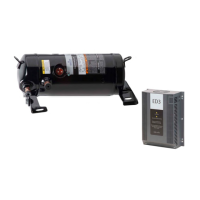11
© 2015 Emerson Climate Technologies, Inc.
AE4-1400 R1
charge is higher than the compressor refrigerant
charge limit listed in Table 4; and a capillary tube,
xedorice,orbleed-typeTXVisusedoneither
the indoor or the outdoor coil of the unit.
Continuous Floodback Test
Itisexpected that the design would not ood during
standard air conditioning operation. Running a partially
blockedindoorairlterorlossofevaporatorairowtest
and comparing the sump temperature results to Figure
2 is recommended. The use of a TXV in heating does
notguaranteeoperationwithoutoodbackinthelower
end of the unit/TXV operating range.
Totestforexcessivecontinuousliquidrefrigerantood
back, it is necessary to operate the system in a test
roomatconditionswheresteadystateoodbackmay
occur (low ambient heating operation). Thermocouples
should be attached with glue or solder to the center of
the bottom shell and to the suction and discharge lines
approximately 6 inches (15 cm) from the shell. These
thermocouples should be insulated from the ambient air
with Permagum® or other thermal insulation to be able
to record true shell and line temperatures. If the system
isdesignedtobeeldcharged,itshouldbeovercharged
by 15% in this test to simulate overcharging often found
ineldinstallations.
The system should be operated at an indoor
temperature of 70°F (21°C) and outdoor temperature
extremes of 10°F (-12°C) or lower in heating to
produce flood back conditions. The compressor
suction and discharge pressures and temperatures
as well as the sump temperature should be recorded.
The system should be allowed to frost up for several
hours (disabling the defrost control and spraying
water on the outdoor coil may be necessary) to cause
the saturated suction temperature to fall below 0°F
(-18°C). The compressor sump temperature must
remain above the sump temperature shown in Figure 2
or design changes must be made to reduce the amount
ofoodback.Ifanaccumulatorisused,thistestcan
be used to test the effectiveness of the accumulator.
Increasing indoor coil volume, increasing outdoor air
ow,reducingrefrigerantcharge,decreasingcapillary
ororicediameter,andaddingachargecompensator
can also be used to reduce excessive continuous liquid
refrigerantoodback.
Field Application Test
To test for repeated, excessive liquid ood back
during normal system off-cycles, perform the Field
Application Test that is outlined in Table 2. Obtain a
sample compressor with a sight-tube to measure the
liquid level in the compressor when it is off.
Note: The sight-tube is not a good liquid level indicator
when the compressor is running because the top of
the sight-tube is at a lower pressure than the bottom
causing a higher apparent oil level.
Set the system up in a conguration with the indoor
unit elevated several feet above the outdoor unit with
a minimum of 25 feet (8 meters) of connecting tubing
with no traps between the indoor and outdoor units. If
thesystemisdesignedtobeeldcharged,thesystem
should be overcharged by 15% in this test to simulate
eldovercharging.Operatethesysteminthecooling
mode at the outdoor ambient, on/off cycle times, and
number of cycles specied in Table 2. Record the
height of the liquid in the compressor at the start of
each on cycle, any compressor overload trips, or any
compressor abnormal starting sounds during each
test. Review the results with Application Engineering
to determine if an accumulator or other means of off
cycle migration control are required. This test does not
eliminate the requirement for a crankcase heater
if the system charge level exceeds the values in
Table 4. The criteria for pass/fail is whether the liquid
level reaches the level of the compressor suction tube
connection. Liquid levels higher than this can allow
refrigerant/oil to be ingested by the scrolls and pumped
out of the compressor after start-up.
The tests outlined above are for common applications
of compressors in this family. Many other applications
of the compressor exist, and tests to insure those
designs can’t possibly be covered in this bulletin.
Please consult with Application Engineering on
applications outside of those outlined above for the
appropriate application tests.
ASSEMBLY LINE PROCEDURES
Installing the Compressor
WARNING
Use care and the appropriate material handling
equipment when lifting and moving compressors.
Personal safety equipment must be used.
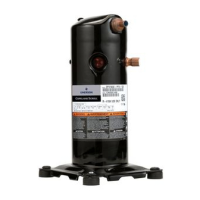
